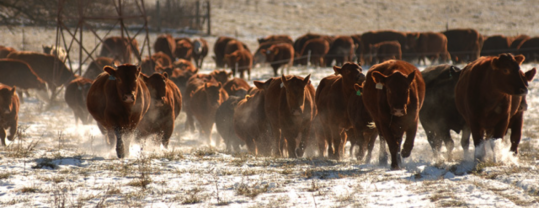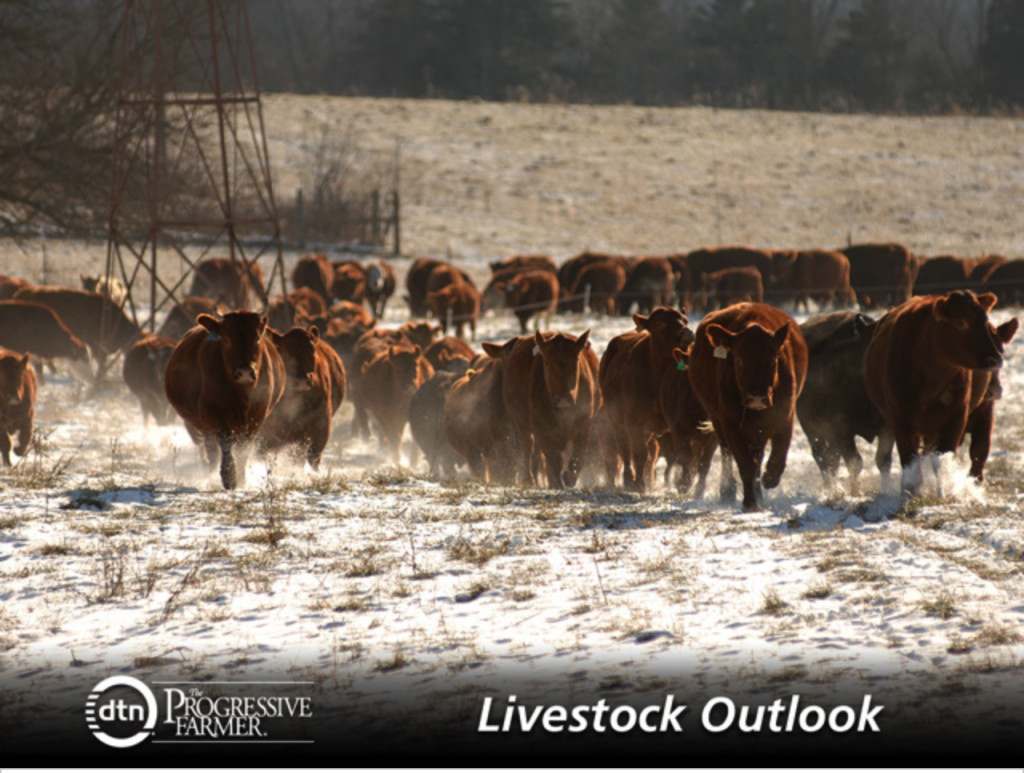OMAHA (DTN) — Livestock exports will likely improve in 2016, but foreign trade and domestic beef demand will be vital issues in 2016, according to experts.
DTN Livestock Analyst John Harrington said he believes 2016 exports will improve over their performance seen in 2015, especially beef. He said he looks for U.S. beef, pork and poultry exports to be up 9%, 5% and 9%, respectively.
The strengthening U.S. dollar could also affect exports in 2016, Harrington said.
“If the dollar continues to gain on foreign currency as it did through 2015, export demand could turn out to be softer than I currently imagine,” he said. “That would be bad news for domestic price potential with U.S. consumers asked to eat even more meat.”
There is much uncertainty about domestic beef demand, especially after wholesale prices imploded in the second half of 2015. Harrington said the big question will be which one was the aberration: the strong demand curve seen in the first half of 2015, or the weak demand curve seen in the second half of the year?
Assuming that foreign trade is generally more helpful during the year and feed costs remain relatively low, Harrington said he expects livestock feeding margins to generally improve, especially in the case of fed cattle.
While feedlot prices will probably average below 2015 (likely to range between a winter low near $125 and a spring/early summer high of $150), feeding profits stand to be much better thanks to lower breakevens. He added that it may also mean lower price expectations for ranchers.
If pork producers can continue to increase exports in 2016, Harrington expects an annual average somewhere between $45 and $50 on a live basis with the next profit opportunity likely to surface near midsummer.
With meat supplies set to be larger in 2015 and modest increases expected in beef, pork and poultry, Harrington said he expects per capita meat consumption to be about 2% higher, around 213 pounds, across the board.
Cattle market watchers will be carefully monitoring the pace of ongoing herd expansion. While probably substantial in 2015, the big question is whether the high tide of red ink will slow it down going forward.
MORE BEEF PRODUCTION IN 2016
With expansion in the U.S. beef herd in 2014 and 2015, 2016 will bring a bigger herd and more calves going to market, according to Kathleen Brooks, beef livestock economist at the University of Nebraska-Lincoln. Although prices fell in 2015, Brooks said she expects weaker prices in 2016, but not as low as in 2015.
“We have been expanding the herd at a rapid pace the last three years, so that will put us on a downturn on prices,” she said.
Brooks also said she expects volatility in prices to continue to play out into 2016, making understanding markets and how to market calves, vital in 2016 and 2017.
Demand for beef will be another concern in 2016, Brooks said. While demand has been relatively strong, as the industry pushes for more beef demand, prices in the retail sector may begin to fall.
Export markets will also bear watching as the strengthening U.S. dollar and global economies could affect exports.
“We probably won’t see increases in the export market unless we see some real big improvements in global economics,” Brooks said.
U.S. DAIRY PRICES VS. WORLD PRICES
A vital topic for the dairy industry will be U.S. prices relative to world prices, according to Robin Schmahl, hedge and market specialist and DTN contributing dairy analyst.
The U.S. has been consistently maintaining higher prices than world prices, which has really affected exports, Schmahl said. Even if U.S. prices fall, it may take a while for the U.S. to be competitive.
“If we start seeing the U.S. being competitive, it’s probably going to take six or nine months before that starts being reflected in our export capacity,” he said.
The dairy industry will also be looking at how to slow down milk production in light of milk prices that are $6 to $7 per hundredweight lower than last year, Schmahl said. Record milk output, milk prices substantially below last year and projections of even lower prices in 2016, could lead to heavier culling and a pullback on production in the U.S., depending on the duration of low prices.
Internationally, the industry will be waiting to see whether China is going to step up and purchase more dairy products from both the U.S. and other countries to reduce some of the burdensome supplies.
The inventory for dairy products may also be an issue, as there was not much of a decline in cheese products inventory in 2015.
“We’re going to start the year at a higher level than we were a year ago, and with the slow down on exports, we could actually back up on butter and cheese inventories at a faster pace than usual because we didn’t see the draw down,” he said, adding that cheese storage facilities may be hard to come by.
HEALTH ISSUES TOP CONCERNS FOR PORK INDUSTRY
A major focus of the pork industry in 2016 will be a focus on swine health, according to Gerald Shurson, professor of swine nutrition and management at the University of Minnesota.
A major accomplishment has been that researchers from Kansas State University and the University of Missouri have developed pigs that are resistant to Porcine Reproductive and Respiratory Syndrome (PRRS), a common virus that is estimated to have caused about $10 billion in losses since it arrived in 1987. Also, researchers at Iowa State University have identified the virus that causes Congenital Tremor (CT) or shaking piglets, a disease that causes muscle tremors in baby pigs.
On the negative side, Shurson said a third strain of the Porcine Epidemic Diarrhea Virus (PEDv) has been identified. This virus had dramatic negative effects on baby pig mortality a couple of years ago.
Another health concern is the Seneca Valley Virus, generally not a life-threatening virus, but it has similar characteristics to the Foot and Mouth Disease virus and could confuse farmers as they try to identify what is affecting their swine.
“Researchers are going to be spending more time trying to develop diagnostic tests, vaccines and learning how to deal with some of these new, potential health issues,” Shurson said.
A second issue for the swine industry will be the implementation of the Veterinary Feed Directive that will eliminate the use of most antibiotics as growth promoters. The new rule became effective in October 2015, with full enforcement becoming effective in December 2016, he said.
Once in effect, antibiotic use will only be allowed for the prevention and treatment of diseases, and only used under veterinary prescription. Shurson said that researchers have been working to try to identify antibiotic alternatives to growth promotion.
Another continuing issue will be pressure on the swine industry from animal rights activists, as well as from consumers concerned about animal welfare.
The pork industry has been proactive and made such changes as evolving away from individual sow gestation stalls and moving more toward group housing in response to consumer perceptions of the welfare of sows in confinement.
“Consumer groups are becoming more interested in how their meat is produced,” he said, “so that’s putting pressure on production systems in the industry to use best management practices and ensure optimal animal welfare.”
POULTRY INDUSTRY TO CONTINUE FOCUS ON BIOSECURITY
The poultry industry will continue to monitor and bolster biosecurity efforts in anticipation of the return of Avian Influenza (AI), according to Tom Super, senior vice president of communications for the National Chicken Council.
“Heightened biosecurity and collaboration between the industries, state veterinarian and the Animal and Plant Health Inspection Service at the federal level is going to be the new normal moving forward,” Super said.
Because of the past issues with AI, the poultry industry will focus on exports and trade in 2016. Even though the commercial broiler sector was largely unaffected by AI, a number of U.S. trading partners banned all U.S. poultry exports, causing a considerable loss of exports in 2015.
Some trading partners took a regionalized approach and banned specific counties or states for a certain amount of time; however, some countries like China imposed a blanket ban on all U.S. poultry products. The National Chicken Council is working to get such bans lifted, and is close to resuming exports to South Korea.
The NCC will also be urging Congress to take up the Trans-Pacific Partnership trade agreement between the U.S., Canada and several countries in the Pacific Rim. The agreement holds potential for increased U.S. poultry exports if passed, especially to Canada, Vietnam and Japan.
There will also be new food safety requirements for the poultry industry; it will institute new salmonella standards by USDA’s Food Safety and Inspection Service for chicken parts. Super explained that currently testing for salmonella at plants is only performed on the whole carcass. The new standard will come out in about a month and will require that chicken parts, once the bird is cut up, to be tested as well.
Cheryl Anderson can be reached at cheryl.anderson@dtn.com
**
Editor’s Note:
Each year, DTN presents an outlook series on what is expected for the year ahead in various areas of agriculture. This is the 14th story in a series DTN is running that looks at what farmers can expect as the hot topics for 2016 in areas such as farm finance, land prices, ag and the environment, agricultural policy, crop inputs, livestock, transportation and others. We welcome your feedback on what you think the year will be like at talk@dtn.com.


